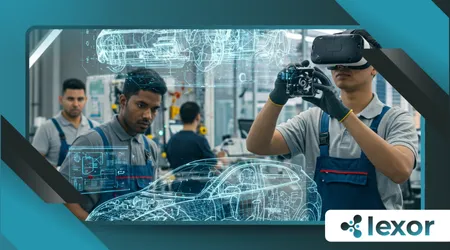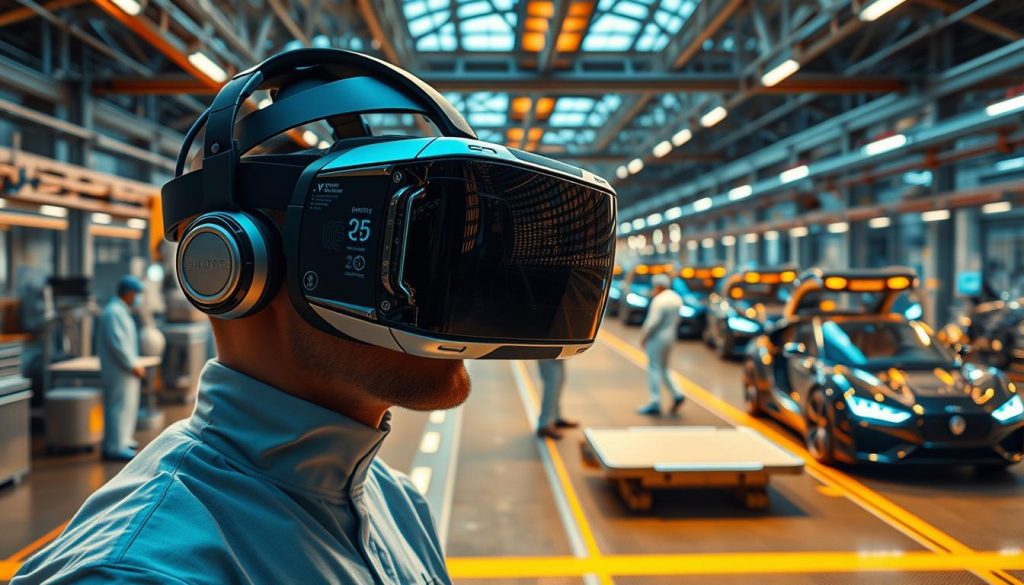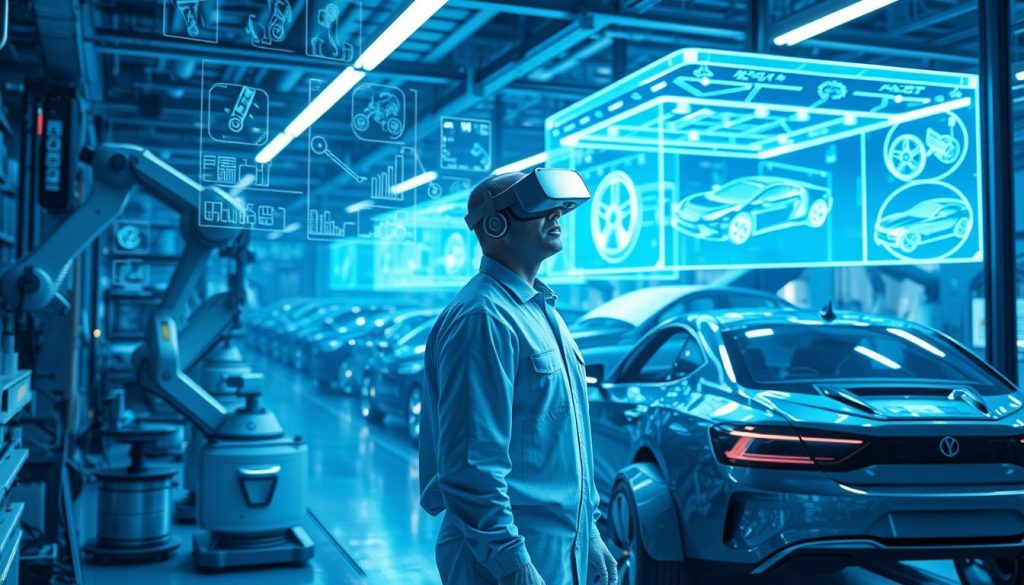How VR is Revolutionizing the Automotive Industry

Have you ever thought about how tech could change driving? VR is changing the car world by making design and experiences easy to use.
Now, you see faster design, cool sales tools, and amazing prototypes. This change is making driving more exciting for today and tomorrow.

Key Takeaways
- You discover how virtual reality adds excitement and realism to car design.
- You witness immersive showrooms that help you explore vehicle details in fresh ways.
- You see how VR is Revolutionizing the Automotive Industry by streamlining project workflows.
- You engage with interactive tools that reduce guesswork and highlight vehicle features.
- You embrace a future-facing approach that inspires bold ideas and smoother collaboration.
Understanding the Evolution of Automotive VR
At first, virtual modeling was basic. Now, we have advanced interactive prototyping. This lets you see your car’s features before it’s made.
Brands like Ford and Tesla are leading the way with VR. They’re making design and production faster and smarter.
This change shows how VR is changing the car industry. Big investments in immersive tech are driving this shift. The Oculus Rift has made companies interested in mixed reality.
For more insights, see this overview. It shows how prototypes improve quickly. This highlights VR’s role in making car design more accurate.
Also Read: How VR is Changing the Way We Experience Travel and Tourism
Designing Next-Generation Vehicles Through Immersive Virtual Prototyping
Immersive virtual prototyping makes your design dreams come true. You can see every detail, from curves to features, without needing many physical models. This speeds up your creative work.
Audi uses Unity to cut down on prototyping costs. This helps teams make better decisions faster. It shows how VR is changing the car industry for the better.
Ford also uses virtual design reviews to save time. They can improve ideas quickly. Teams work together in real time, solving problems together.
Waymo tests self-driving cars in digital spaces. They run through many driving scenarios. This makes the cars safer before they hit the road.
Interactive prototypes let you add details and layouts easily. VR is changing how we design cars at every step. It makes each milestone better.
Enhancing Safety and Driver Training with VR Simulators
VR simulators put you in real driving situations. You face slippery roads and sudden obstacles. This helps improve your reaction time and teaches safe driving.
Car companies are adding AI for safety. VR training works with these features. It helps drivers feel confident by facing dangers in a safe way.
VR is also good for equipment operators and emergency responders. It prepares them for tough situations. This makes them think faster and drive safer.
VR is changing how we train drivers. It saves money, lowers risks, and makes roads safer. It updates old ways with new tech.
++How are smart homes helping people with disabilities?
Boosting Customer Engagement at Dealerships
Virtual showrooms let you explore models and features at your own pace. They grab your attention faster than old-school setups. This sparks deeper connections.
Audi launched over 400 lounges with immersive stations. This shows how VR is changing the car industry right now.
BMW also used VR@Retail. It lets you customize and interact with cars before buying. This makes shopping more exciting and builds trust.

Nissan offered a remote test drive for its LEAF. Toyota showed cars in malls. These moves show how versatile VR can be.
These virtual experiences make you remember them. They inspire you to take action. You’ll see how VR is changing the car world and helping dealerships succeed.
Also Read: The Future of Virtual Reality: What to Expect in the Next Decade
Why VR is Revolutionizing the Automotive Industry for Automakers Everywhere
Your brand grows when technology meets vision. VR brings your design dreams to life in 3D. It offers global teams new ways to perfect every idea.
Hyundai’s digital design system shows how shared creativity can speed up car making. Real-time feedback cuts down on repeated prototypes and lowers costs.
Designers used to need many clay models. Now, they save nearly 80% of physical effort. VR is changing the game in the automotive world.
Teams from Europe to the USA work together live in VR. This method cuts down on travel and supports eco-friendly goals for brands like Hyundai.
Teams use VR to check designs from all sides, needing fewer clay models. This change reduces costs, saves time, and cuts carbon emissions.
| VR Benefit | Impact |
|---|---|
| Reduced Physical Models | 80% of interior design tasks handled virtually, requiring fewer clay prototypes |
| Real-Time Collaboration | Engineers and designers align rapidly across multiple global sites |
| Environmental Gains | Less travel and cuts in carbon emissions drive greener operations |
Reimagining Maintenance and Repair Processes
New diagnostic tools help you find mechanical problems early. Predictive sensors watch over your car’s parts, fixing issues before they get worse.
Using these tools with virtual guidance makes repairs faster and more accurate. Companies like Ford use VR for maintenance, cutting down on service time.

VR is changing the car industry by making service visits smoother and more reliable. It sends alerts for maintenance, avoiding sudden car failures and delays.
Learn how AR/VR in manufacturing leads to better diagnostics on the spot. You work with techs online, solve complex problems, and make cars last longer.
Augmented Training Modules for Technicians
Your workshop gets a new view with immersive modules. VR lets trainees practice hands-on, boosting confidence. It prepares them for real-world challenges.
Top brands are diving into virtual training. BMW teams up with Strivr for instant feedback. Ford and Bosch teach about electric systems with interactive modules.
This focus on immersive training shows VR’s big impact on the auto industry. You see fewer mistakes and save time on tough tasks.
This teamwork shows VR’s big role in the auto industry for learners. It helps you learn new systems faster.
Audi uses gamified tasks to motivate technicians, where they earn points. Porsche works with Siemens for easy solutions on electric models. This guides service teams better.
| Brand | VR Feature | Potential Impact |
|---|---|---|
| BMW & Strivr | Immediate Feedback | Enhanced Troubleshooting |
| Ford & Bosch | Electric System Modules | Better Prepared Technicians |
| Audi | Gamified Training | Stronger Skill Retention |
Leveraging VR for Regulatory Compliance
Testing is key to follow safety and emissions rules. VR offers controlled simulations to check these standards.
This method shortens your certification time, lowers costs, and ensures clear rules in North America. Volkswagen and Audi have already seen its benefits.
Simulated tests help reduce emissions and boost compliance. You get to see how vehicles perform without real-world risks. VR is changing the game in the automotive world.
Working with top brands helps you create cars ready for the future. You can meet all standards easily. This boosts your confidence in following every rule with less trouble.
Conclusion
VR is changing the car world, from new ideas to big testing labs. These labs use virtual reality to test cars.
The AR and VR world grew from $195.7 million in 2018 to $1.216 billion by 2023. This shows VR’s big impact on cars.
Engineers now skip expensive prototypes. They use virtual showrooms to fine-tune designs. They also test crashes safely without real parts.
This method shortens design times, makes cars safer, and increases assembly accuracy to 96%. It helps you stay ahead in a fast-changing market.
Using these tools, your next car model will be better. You’ll start a new era of comfort and fun for drivers.
